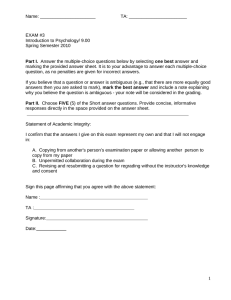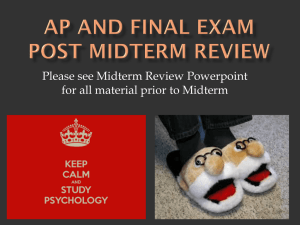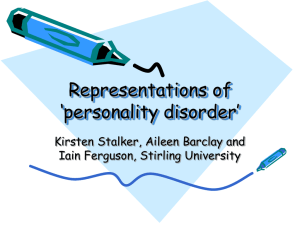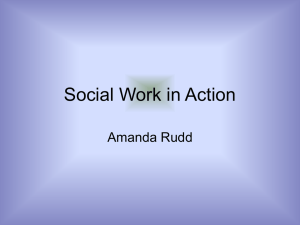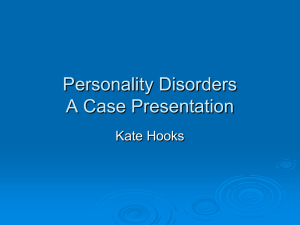Name: ______________________ TA: _______________________ EXAM #3 Introduction to Psychology/ 9.00
advertisement
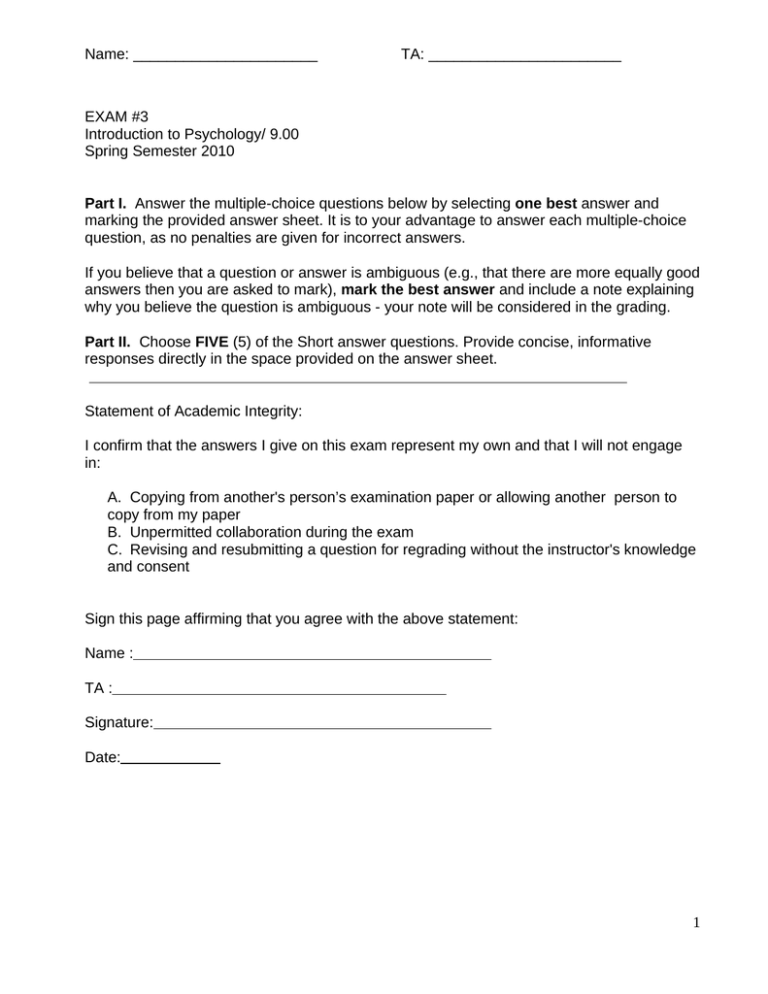
Name: ______________________ TA: _______________________ EXAM #3 Introduction to Psychology/ 9.00 Spring Semester 2010 Part I. Answer the multiple-choice questions below by selecting one best answer and marking the provided answer sheet. It is to your advantage to answer each multiple-choice question, as no penalties are given for incorrect answers. If you believe that a question or answer is ambiguous (e.g., that there are more equally good answers then you are asked to mark), mark the best answer and include a note explaining why you believe the question is ambiguous - your note will be considered in the grading. Part II. Choose FIVE (5) of the Short answer questions. Provide concise, informative responses directly in the space provided on the answer sheet. Statement of Academic Integrity: I confirm that the answers I give on this exam represent my own and that I will not engage in: A. Copying from another's person’s examination paper or allowing another person to copy from my paper B. Unpermitted collaboration during the exam C. Revising and resubmitting a question for regrading without the instructor's knowledge and consent Sign this page affirming that you agree with the above statement: Name : TA : Signature: Date: 1 Name: ______________________ TA: _______________________ Lecture and Sacks Questions (1pt each) 1. Which is NOT true about measures of personality? A. conscientiousness appears to diminish risk of Alzheimer’s disease B. children are more similar to an adoptive sibling than to any randomly selected child C. their stability increase with age D. personality traits, according to twin studies, are about 50% heritable 2. If you are extroverted and have to take a test, research indicates that to perform best you should A. consume caffeine if the test is in the morning, but do not consume caffeine if the test is in the afternoon B. consume caffeine if the test is in the afternoon, but do not consume caffeine if the test is in the morning C. consume caffeine for a test either in the morning or in the afternoon D. do not consume caffeine for a test either in the morning or in the afternoon 3. Infants show remarkable abilities by two years of age EXCEPT for which ability? A. imitation of facial movements by an adult B. noticing different size squares on sequentially presented checkerboards C. enjoying control over their environment D. understanding the false beliefs of another person 4. What is NOT true about theory of mind? A. it matures at different ages across different cultures B. it matures earlier in children with older siblings C. it matures late in children with autism D. it matures during the pre-operational period as described by Piaget 5. Age influences specific brain functions related to emotion and reward. Which of these is NOT true according to research studies? A. nucleus accumbens activation in anticipation to reward is greater in adolescence than either childhood or adulthood B. reward-related activation in older people is like that of younger people in anticipation of potential gain, but reduced in anticipation of potential loss C. amygdala activation in older adults is reduced for emotionally negative scenes but not reduced for emotionally positive scenes D. frontal-lobe activation in older adults with successful cognitive aging is more asymmetric than in younger adults 2 Name: ______________________ TA: _______________________ 6. Age influences patterns of cognitive and memory performance. Which of these is NOT true according to research studies? A. older adults show a disproportionate decline in memory for negative pictures B. children exhibit more false memories than adults C. children are less future oriented than adults D. young children have less loss aversion than adults in decision making 7. Which brain regions have been associated with (1) greater risk for PTSD in war and (2) physical pain and the social pain of exclusion? A. (1) hippocampus and cingulate cortex; (2) amygdala B. (1) cingulate cortex; (2) amygdala and hippocampus C. (1) amgygdala and cingulate cortex; (2) hippocampus D. (1) hippocampus and amygdala; (2) cingulate cortex 8. Adaptive physiological changes that occur in response to acute stress include all of the below EXCEPT A. suppression of cardiovascular tone B. suppression of digestion C. suppression of immune system D. suppression of growth 9. A survey of 5,000 young adults, ages 19-25, revealed that A. about 80% had a psychiatric disorder in the past year, and less than 50% with a disorder sought treatment B. about 10% had a psychiatric disorder in the past year, and less than 5% with a disorder sought treatment C. about 50% had a psychiatric disorder in the past year, and less than 25% with a disorder sought treatment D. about 50% had a psychiatric disorder in the past year, and about 1% with a disorder sought treatment 10. The probability that if one identical (monozygotic) twin is diagnosed with schizophrenia, so will the other twin is A. 90% B. 50% C. 10% D. 1% 3 Name: ______________________ TA: _______________________ 11. Neuroimaging studies have revealed atypical function or structure in particular brain regions associated with particular psychiatric diseases. Disturbance of the _________ is associated with schizophrenia; _______ is associated with depression; _______ is associated with obsessive-compulsive disorder; and _____ is associated with ADHD. A. prefrontal cortex; subgenual cingulate; basal ganglia; caudate and putamen B. subgenual cingulate; caudate and putamen; prefrontal cortex; basal ganglia C. basal ganglia; caudate and putamen; subgenual cingulate; prefrontal cortex D. caudate and putamen; basal ganglia; prefrontal cortex; subgenual cingulate 12. Two common treatments for psychiatric disorders are (1) various drugs and (2) various behavioral treatments such as cognitive behavioral therapy. According to research studies, which is NOT true about these two kinds of treatment? A. for obsessive-compulsive disorder (OCD), behavioral treatment alone was more effective than drug treatment alone B. for depression, drugs and behavioral treatment were similarly effective for the short run (16 weeks), but drugs were more effective in the long run (24 weeks) C. for ADHD, drug treatment alone was more effective than behavioral treatment alone D. for depression, only patients with very severe depression show a greater response to a drug than to a placebo 13. Experimental studies have shown that people are prone to conform to the opinions of others. Which factor increases conformity in experimental studies? A. the presence of an ally B. the opportunity to avoid embarrassment by giving private responses C. coming from an interdependent culture D. a smaller group 14. What factor has been shown in experiments to increase the willingness for a bystander to help somebody? A. the presence of many people B. the presence of experimental confederates who do not help C. recent consideration of the importance of helping others D. not being in a rush for an appointment 15. In Festinger’s original experiment examining cognitive dissonance, people took a boring test, and were then paid either $1 or $20 to lie and tell the next person that task had been interesting. When later asked to evaluate how truly interesting the task had been, who rated the task as most enjoyable? A. the people who lied and were paid $20 B. the people who did not lie C. the people who lied and were paid either $1 or $20 equally D. the people who lied and were paid $1 4 Name: ______________________ TA: _______________________ 16. On average, people from a collectivist culture (e.g., Japan) differ from people from an individualistic culture (e.g., United States) in several ways. Which answer below is INCORRECT about ways in which people from collectivist cultures tend to differ from people from individualistic cultures? A. People from a collectivist culture draw more accurately a line that is the same length relative to a line and a box (frame) previously seen B. People from a collectivist culture remember an object (like a fish) more accurately when it is later tested for without the original background C. People from a collectivist culture are less prone to the fundamental attribution error D. People from a collectivist culture are less susceptible to the attractiveness bias 17. Research has shown that people with autism exhibit all of the following atypicalities EXCEPT which one? A. different visual scanpaths when looking at faces freely B. different visual scanpaths when looking at faces to identify emotions C. different responses in brain area MT to moving objects D. different responses in the superior temporal sulcus to biological motion 18. Research has shown all of the below EXCEPT which one? A. Women are more selective in choosing possible dates at speed-dating events regardless of whether the men or women rotate seats at the events. B. Lottery winners are no happier than other people a year or two after their lottery win. C. Students are happier after having a choice of which picture to give away when the choice is irrevocable than when they have the opportunity to reverse their choice in a few days. D. A person is more likely to find other people warm or give away something to a friend after exposure to a warm object (cup, therapeutic pad) than a cold object. 19. In the Oliver Sacks chapter, the patient with Tourette’s syndrome was treated with Haldol and all EXCEPT which of the below occurred? A. there was an immediate positive influence on his daily life B. he chose eventually to take the medication during the week and not during the weekend C. his job situation and home life improved D. he became worse at ping-pong 20. In the Oliver Sacks chapter, all EXCEPT which of the below was true about the woman with “Cupid’s disease” A. she had syphilis from her days of prostitution B. she became flirtatious at the age of 88 C. penicillin ended her disinhibition D. penicillin killed the spirochetes evident in her spinal fluid 5 Name: ______________________ TA: _______________________ Book Questions (1pt each) 21. Which of the following is a named superfactor in the “Big Five” personality definition? A. Sensation-seeking B. Attentiveness C. Neuroticism D. Security 22. Which of the following is the most difficult source of bias in personality inventories to correct? A. Social Desirability Bias B. Response Bias C. Introspective unawareness D. Test-Retest reliability 23. The estimated heritability of commonly used personality measures (e.g., the “Big Five”, or Eysenck’s personality dimensions) is approximately: A. 0-20% B. 20-35% C. 35-60% D. Heritability can not be estimated by psychologists 24. What best describes the relationship between Grays’s Behavioral Activation System (BAS) and Eysenck’s theoretical Extroversion dimension? A. People with a readily activated BAS are more likely to be extroverts, because the cortex of extroverts is harder to excite B. People with a readily activated BAS are less likely to be extroverts, because the cortex of extroverts is harder to excite C. People with a readily activated BAS are more likely to be extroverts, because the cortex of extroverts is more easily excited D. People with a readily activated BAS are less likely to be extroverts, because the cortex of extroverts is more easily excited 6 Name: ______________________ TA: _______________________ 25. An unfortunate student sleeps through the final exam. Which of the following is he most likely to use as his excuse if he has an internal locus of control? A. “My alarm didn’t go off; there must have been a power outage!” B. “My roommate kept me up until 5am talking about his girlfriend problems! I was exhausted!” C. “There was an epic game of beer pong and I drank so much that I forgot to set my alarm!” D. “My fraternity brothers played a practical joke on me and replaced my DayQuil with NyQuil!” 26. Which of the following is a good example of a teratogen? A. Taking folic acid during pregnancy B. Playing music to a fetus C. Drinking several cups of coffee per day during pregnancy D. Eating chocolate during pregnancy 27. When you stroke an infant’s foot and the big toe flexes while the other toes fan out, what major reflex are you observing? A. Plantar reflex B. Babinski reflex C. Startle reflex D. Rooting reflex 28. What kind of paradigm used to study infant cognition involves showing a baby a stimulus until he or she becomes bored? A. Habituation paradigm B. Operant conditioning paradigm C. Impulsivity paradigm D. Visual cliff paradigm 29. Which of the following senses does not decline with age? A. hearing B. vision C. taste D. smell 30. According to Erikson’s theory of psychosocial stages, which of the following conflicts is most likely to be experienced during young adulthood? A. Identity vs. role confusion B. Intimacy vs. isolation C. Generativity vs. self-absorption D. Integrity vs. despair 7 Name: ______________________ TA: _______________________ 31. What are the three stages of Selye’s general adaptation syndrome, in order? A. fight-or-flight, defense, withdrawal B. alarm, resistance, exhaustion C. allostatic load, stress, return to normalcy D. denial, adaptation, acceptance 32. Internal conflicts can lead to stress. Match each person’s scenario with the type of internal conflict it would most likely produce: Mark has been accepted into graduate programs at both MIT and Harvard. Jason has to tell a lie about workplace safety, or his boss will fire him. Terry just got offered a big promotion, but he’ll have to work nights and weekends. A. Mark: approach-avoidance conflict; Jason: approach-approach conflict; Terry: avoidance-avoidance conflict. B. Mark: avoidance-avoidance conflict; Jason: approach-avoidance conflict; Terry: approach-approach conflict. C. Mark: approach-approach conflict; Jason: avoidance-avoidance conflict; Terry: approach-avoidance conflict. D. Mark: approach-approach conflict; Jason: approach-avoidance conflict; Terry: avoidance-avoidance conflict. 33. What is the most important component of Type A personality in predicting heartdisease? A. neuroticism B. depression C. conscientiousness D. hostility 34. What is the hostile attribution bias? A. Behavior intended to harm others who don’t want to be harmed B. The propensity to misread the intentions of others as negative C. The personality trait associated with heart disease and characterized by mistrust and a cynical attitude. D. A variation on the placebo effect, in which a person expects a negative outcome instead of a positive one. 35. Which of the following best describes the effects of social support on stress? A. Perceived social support provides a bigger benefit than enacted social support. B. All social contact is beneficial in dealing with stress. C. People who have many friends have more perceived social support. D. People who receive the most enacted social support also report the greatest perceived social support. 8 Name: ______________________ TA: _______________________ 36. Which of the following people would probably not be diagnosed as psychotic? A. A man who believes space aliens monitor his thoughts. B. A man who constantly yells at unfamiliar strangers, believing that they are plotting to steal his girlfriend. C. A non-believer who hears “the voice of God” in his head and believes it to be real D. A devout church-goer who hears “the voice of God” in his head and believes it to be real 37. The “diathesis-stress” model of psychological disorders holds that: A. Some people are predisposed to a condition, such as depression, but require an additional environmental factor before the disorder is manifested B. Sufficient amounts of stress are enough to create psychological disorders, even in healthy people C. Psychological disorders are never really cured, but may reemerge under conditions of sufficient stress D. Many psychological disorders do not have a biological cause, but are created by the cultural attitude towards abnormal behavior 38. The Diagnostic and Statistical Manual of Mental Disorders was historically created to assist medical professionals in diagnosing a patient’s condition. Which is not true of the DSM? A. Axis I notes clinical disorders, such as major depression B. Axis II notes personality disorders, such as borderline personality disorder C. Axis III notes medical conditions that may create psychological symptoms, such as brain tumors D. The DSM is rarely used today, as neuroimaging can more reliably identify most psychiatric conditions. 39. Which best defines dysthymia? A. A movement disorder often caused by psychoactive medication B. A less intense but longer-lasting form of depression C. A mood characterized by fast, disconnected thoughts D. The early phase of a bipolar episode, before symptoms become severe. 40. Which best explains the relationship between attributional style and depression? A. People who attribute blame to themselves after a negative life event are more likely to become depressed, but only if the attribution is accurate B. People who attribute blame to others after a negative life event are more likely to become depressed, but only if the attribution is accurate C. People who attribute blame to themselves after a negative life event are more likely to become depressed, regardless of the accuracy of their attribution. D. People who attribute blame to others after a negative life event are more likely to become depressed, regardless of the accuracy of their attribution 9 Name: ______________________ TA: _______________________ 41. Which of the following was not part of Freud’s psychoanalysis? A. Dream analysis B. Exposure C. Free association D. Hypnosis 42. Dinah, a therapist, works with her clients to help them change their problematic behaviors and irrational thoughts and provide new, more adaptive behaviors and beliefs to replace old, maladaptive ones. Dinah uses what type of therapy? A. Psychoanalysis B. Client-centered C. Cognitive-behavior D. Electroconvulsive 43. In behavior therapy, distressing symptoms are seen primarily as: A. The result of learning B. The result of your unconscious impulses C. The result of repressed desires D. A chemical imbalance 44. Which of the following behavior therapy techniques would best be used to treat phobias and anxiety disorders? A. Free association B. Interpretation C. Exposure D. Dream analysis 45. SSRIs and similar pharmacological treatments are based on the belief that_________ is involved in depression. A. Too much serotonin B. Too little serotonin C. Too little acetylcholine D. Too much acetylcholine 46. The process of forming impressions about people involves perception of that person. Just like top-down processing can influence sensory perception, it can also influence social perception (forming an impression of someone else) because people often “see” what they expect to see, and in the process, may create a A. Rebound effect B. Self-fulfilling prophecy C. Role D. Disposition 10 Name: ______________________ TA: _______________________ 47. The three basic components of attitudes are ________, ________, and ________. A. cognitive; duration; consistency B. strength; consistency; duration C. behavioral; effective; personal D. cognitive; affective; behavioral 48. Consider the classic experiment where male and female participants (who have never met) were placed in separate rooms. Before they spoke to each other over a telephone, the men were shown pictures of either an attractive woman (group 1) or an unattractive woman (group 2). Importantly, the pictures that the men were shown bore no resemblance to the woman to which they were actually talking. When judges listened to the woman’s side of the phone conversation (without hearing anything that the men said to them), they found that women who talked to men from the first group tended to sound more warm, friendly and flirtatious than women who had spoken to men from the second group. In this study, which people were most likely to have created a self-fulfilling prophecy? A. The women who had talked to men from group 1 B. The women who had talked to men from group 2 C. The men D. The judges 49. Persuasion via simplistic arguments is more likely to work when the other person (the target of persuasion) A. is distracted/inattentive B. is unintelligent C. has a weak attitude about the subject D. is conscientious 50. Stereotypes tend to be resistant to change because A. we are less likely to attend to information that is inconsistent with our stereotypes B. we may create sub-types to explain away exceptions C. we may deny the truth or validity of observed exceptions D. All of the above 11 Name: ______________________ TA: _______________________ Short Answer Questions (4 pts each) (Answer 5 of the following 13 questions) 1. Name 4 factors that minimize cognitive loss in older age 2. Name and define the four dimensions of temperament. (1 point each) 3. According to Piaget, children in the _____________ period lack _________________, the ability to think about objects when they are not present. Children in this stage and also the ________________ period exhibit _______________, which is the inability to take another’s point of view. 4. While ____________ intelligence (A) involves flexible reasoning, ______________ intelligence (B) involves using knowledge for reasoning. _____________ studies, which test the same group of people repeatedly at various time points, have found that both types of intelligence have been shown to be relatively stable until somewhere between the mid-50s and the 70s. However, ____________ studies (simultaneously testing different groups at different ages) have found that (A) declines before (B). 5. Optimists expect positive outcomes for events, whereas true pessimists and defensive pessimists both expect negative outcomes. What is the difference between the negative expectations of true and defensive pessimists? (2pts). How do optimists and defensive pessimists compare on objective measures of outcome? (1pt) Why is this the case? (1pt). 6. Identify two problem-focused coping strategies (1&2); and two emotion-focused coping strategies (3&4). 7. Define an obsession, and provide an example. Define a compulsion and provide an example. Explain how they are different. 8. Name and define the four subtypes of schizophrenia 9. Name four of the five common cognitive distortions. 12 Name: ______________________ TA: _______________________ 10. Name four of the six relational-emotive behavior therapy techniques used in the ABCDEF method. 11. People are often biased in their assessment or interpretation of the underlying causes of other peoples’ behaviors, as well as their own. Indeed, such ___________ are believed to be cognitive shortcuts for reading other people’s behavior and intentions. There are three major classes of biases in this regard, including the __________ bias, which is the strong tendency to interpret other people’s behavior as caused by internal factors rather than external ones; the __________ bias, which is the tendency people have to attribute personal failures to extrinsic factors and successes to intrinsic factors, while tending to make the opposite assumptions about other people; and lastly, the “_________” bias, which is the distorted belief that “justice will always prevail”. 12. __________ refers to a change in behavior elicited by a direct request rather than social norms. Many techniques for achieving this have been developed; for example, the _________ technique works by first making an insignificant request in order to prime the target for subsequent larger requests. The reverse of this approach, the ___________ technique, works by first making a large request (that is expected to be declined), followed by smaller requests. In the extreme case, __________ refers to when someone follows an order as opposed to a request. This was the major theme of the famous Milgram Experiment. 13 MIT OpenCourseWare http://ocw.mit.edu 9.00SC Introduction to Psychology Fall 2011 For information about citing these materials or our Terms of Use, visit: http://ocw.mit.edu/terms.
